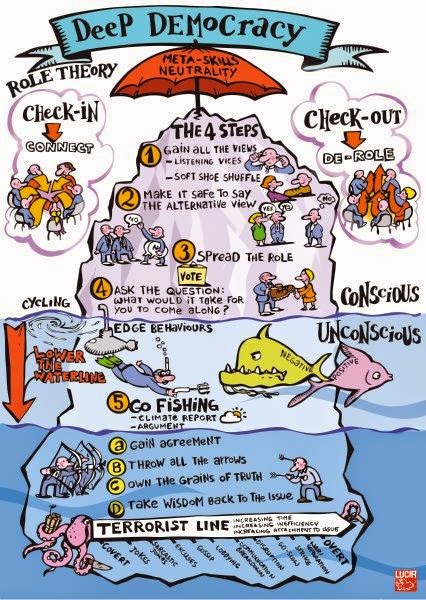Scrum and Yacht Racing - Roles
Watching the development of yacht sailing teams during a campaign, I have always been struck by the similarities between an effective team on a boat and an effective Scrum team.
If we take an X-35 team, it has 7 to 9 members. Each member of the team has a very specific set of skills and a role. A team has a build-up to a race or a series of races in a campaign. Usually there is a main goal - a certain race that stands out like a world cup - combined with a series of smaller events.
Roles
To get an idea of a typical modern sailing team, it is handy to understand what everyone does. Beginning at the back of the boat:
To get an idea of a typical modern sailing team, it is handy to understand what everyone does. Beginning at the back of the boat:
The Tactician can be equated to Product Owner. He or she does not actually do any of the physical work but rather decides where the boat should go. A good tactician knows when to consult with his team and when to make a decision. Depending on what the tactician decides, the necessary manoeuvres become evident. The tactician is responsible for where the boat goes, but not how it gets there.
Next up is the Helmsman, or 'Driver'. In waterfall methods, just as in old-fashioned skipper-led sailing, this would be the project leader. However, in modern sailing, the helmsman is simply a part of the crew. Like a designer, he has a lot of influence on the progress of the team, but he is still a developer and part of the development team.
Then come the trimmers, they set the sails up to give maximum power. Especially when heading upwind, they will often be doing their own thing without involving the rest of the team too much. They are responsible for keeping the boat power optimal - in a car they would be the engine.
In the front of the boat there are the bowman or the bow crew. They have very specific tasks, that affect the handling of the boat: hoisting and dropping sails, tripping shackles, holding and moving gear. They have to work independently yet also together with the rest of the team - in a car they would be the gearbox. In a Scrum team you could compare the trimmers and bow crew to front- and back-end developers.
One team member or otherwise an outsider often takes the role of the trainer - that is what a Scrum Master is supposed to be after all. In fact, I like the fact that not all sailing teams feel the need to appoint a trainer - a really experienced Scrum team should be able to keep to the principles of Scrum without the need for a Scrum Master in the same way.
Self Organising Teams
When I join a boat for the first time as a trainer and I detect that the owner, driver or tactician have an hierarchical view of the roles on board, I often tell them about my experiences as a bowman. As a student, I started yacht racing aboard a boat where the owner was the helmsman (the driver) as well as being the tactician and the brains, if not the hands, of all the trimmers and bow crew. A standard race would consist of this gentleman shouting a series of commands at his crew, whilst he steered the boat and decided where to go. This meant he was effectively deciding everything on board: steering, sail trim, boat handling, tactics and strategy - it was all up to him. In times of stress, he would sometimes leave the helm to do someone else's task if their performance was not to his liking.
When I first started to sail on board of the boat, the results were actually pretty good - the boat achieved good results in the local competition and did fairly well in national events too. However, after a couple of years, I decided it was time to leave. The team kept changing, people would leave, usually after having been shouted at for not following instructions correctly. In the incident that had triggered my leaving, we had run aground because the spinnaker had not come down on time. According to the skipper this was because of my actions as a bowman, according to me it was because he had been shouting at me so much, he had simply forgotten to steer the boat. Whatever the reason in this case, our competition was clearly getting better - we were winning less and less races.
At this time, in the mid 90's, the idea of a self-organising team was becoming a more popular style of leadership on many yachts. The idea being that if each team-member knew his own role and it was up to him to act, the amount of knowledge being used was greater than if it all had to trickle down from the back of the boat. Modern boats were also harder to drive, meaning that a helmsman would sacrifice the quality of their own work if they started involving themselves with what someone else was doing. The trimmers and bow crew communicated with each other instead of via the skipper, losing less time and information in communication.
This method developed - in the team I had joined, we determined who would initiate action for all of the standard manoeuvres that the boat would do. The team that I sail with nowadays has handling-sheets for 16 standard situations, only four of which are initiated by the driver. This is not to say that there is no hierarchy on board - if a snap decision has to be made, the tactician makes the call, but in all other circumstances each position decides on their own actions.
These new methods resulted in the old-fashioned way of doing things, let's call it the skipper-driven (waterfall?) method, being less effective than the new, self-organising method. And that's the nice thing about formal competition - it doesn't get much more empirical than the results in a race.



Comments
Post a Comment